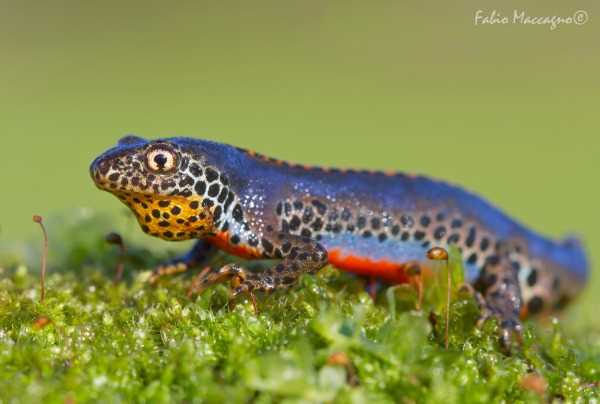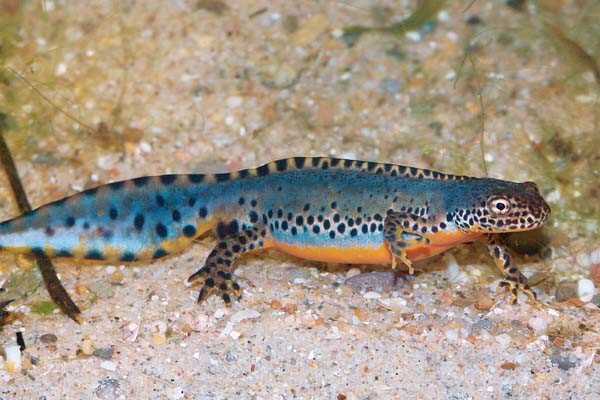
The alpine newt is commonly found in the mountainous regions of Europe, particularly in the Alps. This species has adapted to survive in high-altitude environments, making it a true alpine amphibian. With its striking black and yellow coloration, the alpine newt is easily recognizable and a delight to observe in its natural habitat.
What makes the alpine newt particularly intriguing is its life cycle. Like many other newts, it undergoes metamorphosis, transitioning from an aquatic larva to a fully terrestrial adult. This unique transformation is a testament to the adaptability of this species and its ability to thrive in different habitats.
One of the most remarkable features of the alpine newt is its ability to regenerate body parts. If a predator or other external force damages one of its limbs or tail, the newt can regrow the lost body part over time. This remarkable regenerative capacity is yet another testament to the incredible abilities of this captivating creature.
The Unique Characteristics of the Alpine Newt
One of the most distinctive features of the Alpine Newt is its vibrant coloration. The males of this species have a bright orange belly and throat, while the females have a yellow or light orange coloration. This coloration serves as a warning to potential predators that the newt is toxic.
The Alpine Newt is a semi-aquatic species, which means that it spends part of its life in water and part on land. It is well adapted for both environments thanks to a number of unique characteristics. For example, the newt has webbed feet that enable it to swim efficiently in water. It also has a flattened tail which acts as a rudder, helping it to navigate through the aquatic environment.
Another interesting characteristic of the Alpine Newt is its ability to undergo a dramatic transformation during the breeding season. During this time, the males develop a striking crest along their back and tail, as well as enlarged cloacal glands. These changes are thought to be related to courtship rituals and competition among males for mating opportunities.
The Alpine Newt is an important species for the ecosystems in which it is found. As a predator of small invertebrates, it helps to control populations of insects and other organisms. Additionally, its presence in the environment serves as an indicator of the overall health of the ecosystem.
The Habitat of the Alpine Newt
The habitat of the Alpine Newt is primarily in and around streams and ponds located in alpine and subalpine regions. These regions are characterized by high altitude and cold temperatures, making them the perfect environment for this cold-blooded species to thrive. The Alpine Newt is well-adapted to these mountainous areas, with a range of features that allow it to survive in harsh conditions.
One of the unique characteristics of the Alpine Newt is its ability to tolerate extreme temperatures. During the winter months, when the water freezes, the newt’s metabolism slows down, and it goes into a state of hibernation. It can survive for months without eating and remains dormant until the arrival of spring, when the ice melts and the water temperature rises.
In addition to its ability to withstand cold temperatures, the Alpine Newt is well-suited to its aquatic habitat. It has a streamlined body shape, which allows it to move through the water with ease. It also has webbed feet and a paddle-like tail, which aid in swimming and navigating its watery surroundings.
Overall, the habitat of the Alpine Newt plays a crucial role in its survival and reproductive success. The availability of suitable aquatic environments, such as streams and ponds in the alpine and subalpine regions of Europe, is essential for this remarkable amphibian species to continue thriving in its natural habitat.
Reproduction and Life Cycle of the Alpine Newt
The reproduction and life cycle of the Alpine Newt are quite unique. Like many other amphibians, the Alpine Newt undergoes a process called metamorphosis, which means it goes through distinct stages of development.
The life cycle of the Alpine Newt begins with the female laying her eggs in the water. These eggs are typically attached to aquatic plants or other submerged objects to protect them from predators. The female can lay up to several hundred eggs in one breeding season.
Once the transformation is complete, the Alpine Newt leaves the water and becomes a fully terrestrial adult. The adult newt has a distinct appearance, with bright orange skin and a rough texture. It is well adapted to life on land, but it still needs to return to the water for breeding.
The Alpine Newt typically reaches sexual maturity at around two to three years of age. It then embarks on an annual migration to return to its breeding grounds. During this time, the newts will engage in courtship displays and mate with each other.
After mating, the female Alpine Newt will lay her eggs, completing the reproductive cycle. The new generation of eggs will continue the life cycle, and the cycle will repeat itself for future generations of Alpine Newts.
The Diet and Feeding Habits of the Alpine Newt
Being an amphibian, the Alpine Newt has a dual lifestyle, spending part of its life in water and part on land. It is a highly specialized predator that mainly feeds on small invertebrates such as insects, worms, mollusks, and crustaceans.
The feeding habits of the Alpine Newt are quite interesting. They are skilled hunters and rely on their vision to locate prey. They actively search for food, using their excellent eyesight to detect movement in the water. Once they spot their prey, they make swift and precise movements to capture it.
The Alpine Newt has a specialized feeding technique. It uses its long, sticky tongue to capture prey. The tongue is thrust out with lightning speed, attaching to the prey and retracting back into the mouth, where the prey is then consumed.
Unlike some other amphibians, the Alpine Newt does not have teeth. Instead, it swallows its prey whole. This efficient feeding technique allows the newt to consume a variety of small aquatic organisms.
The diet of the Alpine Newt also varies depending on the availability of food in its environment. In times of scarcity, they may resort to cannibalism, feeding on smaller newts or even their own offspring.
The Predators of the Alpine Newt
One of the most important aspects of the Alpine Newt’s life is its interactions with predators. Despite its relatively large size, the newt faces numerous threats from a variety of predators.
Predatory Fish
Waterfowl and Birds
Other Amphibians

Mammals
Mammals such as foxes, badgers, and rats may also prey on the Alpine Newt. These terrestrial predators can target the newts when they venture away from the water in search of food. Their ability to quickly adapt to various environments makes them successful hunters.
Overall, the Alpine Newt faces numerous predators throughout its life cycle. Its unique adaptations and behaviors are essential for the survival of this fascinating species in its mountain habitat.
The Conservation Status of the Alpine Newt
Threats to the Alpine Newt
Despite its beautiful and distinctive appearance, the Alpine Newt is facing several threats that are putting its population at risk. One of the main threats is the loss and degradation of its habitat. The construction of dams, urbanization, and agriculture practices have all resulted in the destruction of the newt’s breeding sites and water quality degradation.
Another threat comes from the introduction of non-native species, such as predatory fish, which compete with the Alpine Newt for food and pose a threat to its eggs and larvae. Additionally, pollution from pesticides and chemicals used in agricultural practices can also have a negative impact on the newt’s survival.
Conservation Efforts

Due to these threats, the Alpine Newt is listed as a species of concern in several European countries and is protected under various national and international conservation laws. Efforts are being made to conserve the species and its habitat.
A key aspect of the conservation efforts is the restoration and protection of the Alpine Newt’s breeding sites, including the creation of artificial ponds and wetlands. These artificial habitats mimic the natural conditions required by the newt for breeding and provide safe environments for the development of its eggs and larvae.
In addition to habitat restoration, conservation measures also focus on reducing pollution and controlling the introduction of non-native species. This includes promoting sustainable land-use practices, such as organic farming, and implementing strict regulations on the release of non-native species in areas where the Alpine Newt is present.
The Importance of Protecting the Alpine Newt’s Habitat
Protecting the habitat of the Alpine Newt is crucial not only for the survival of this unique amphibian but also for the health and integrity of the ecosystems it inhabits. As a key predator of small invertebrates, the newt plays an important role in controlling populations of insects and other aquatic organisms.
Furthermore, the presence of the Alpine Newt is often an indicator of a healthy and well-functioning ecosystem. Its disappearance from an area may suggest environmental degradation and the loss of other species that rely on similar habitats.
Therefore, it is essential that conservation efforts continue to focus on protecting and restoring the habitat of the Alpine Newt, ensuring the long-term survival of this fascinating and valuable species.
The Importance of Protecting the Alpine Newt’s Habitat
The habitat of the Alpine newt is predominantly aquatic, as it relies on freshwater streams, ponds, and lakes for its survival. These bodies of water provide the necessary conditions for the newt to breed and raise its young. The presence of the Alpine newt in a water body indicates that the water ecosystem is healthy and free from pollutants. Protecting the habitats of the Alpine newt not only benefits the species itself but also ensures the preservation of a diverse range of aquatic organisms.
Furthermore, the Alpine newt plays a crucial role in maintaining the balance of its ecosystem. As a predator, it feeds on small invertebrates, such as insects and their larvae, helping to control their populations. This, in turn, has a cascading effect on the food web, as it prevents an overabundance of prey species. By protecting the habitats of the Alpine newt, we are preserving a natural predator-prey balance and promoting the overall health of the ecosystem.
Conservation efforts aimed at protecting the Alpine newt’s habitat are essential for the preservation of its population. Habitat loss and degradation due to human activities, such as urban development and pollution, pose significant threats to this species. By creating protected areas and implementing sustainable land management practices, we can ensure the continued existence of the Alpine newt and the ecological services it provides.
In addition to its ecological importance, the Alpine newt also holds cultural significance. It is a symbol of the European Alps and serves as a testament to the biodiversity and beauty of this mountainous region. By preserving the habitat of the Alpine newt, we are preserving a part of our natural heritage and promoting the appreciation of these unique and valuable ecosystems.

I’m Lena Adams—a product of an unconventional upbringing in the African wilderness. My father, a daring explorer of African wildlife, sparked my fascination with reptiles, a passion that intertwined with the tragic loss of my mother during an expedition, leaving an indelible mark on my life. Driven to understand the creatures that captivated my parents, I embarked on my journey, sharing insights about reptiles, frogs, and lizards on my website. Through my explorations and conservation efforts, I honour my family’s legacy while seeking connections—to the creatures, nature, and the mother whose presence I yearn to understand.
